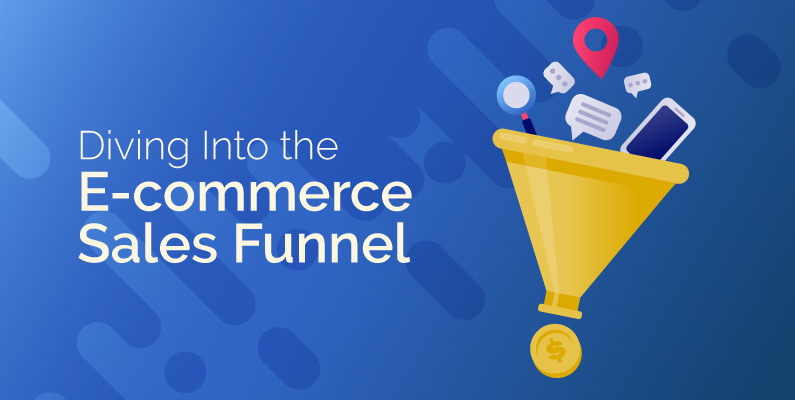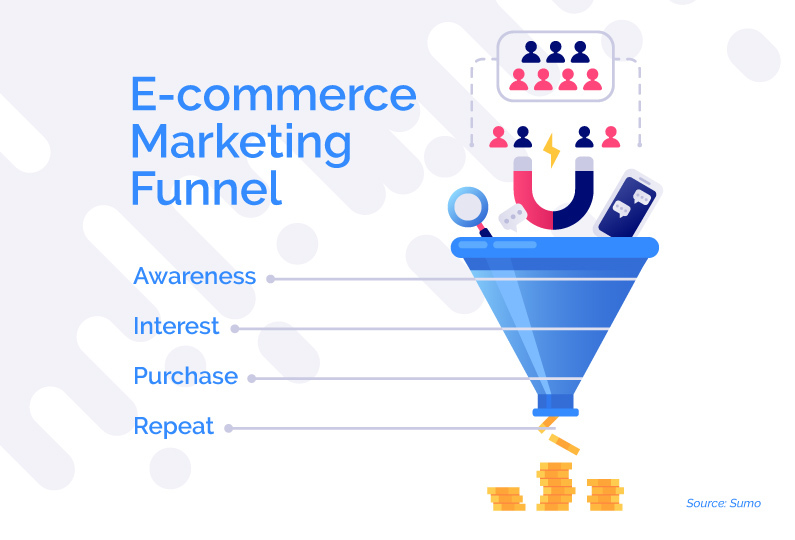Diving Into the E-commerce Sales Funnel
| 5 Min Read

It’s easy to get tunnel vision in e-commerce. Selling a product or service is the ultimate goal for marketers and small business owners, but focusing on it too much can lead to missed opportunities.
Imagine your company attracts 10 people to its website or social media platform. A successful outcome for those users is not necessarily in sales. It could be much simpler. Some users may follow a social media page. Others may start doing research on whether your business is a legitimate option for their needs. The rest might be ready to make a purchase and are just looking for that final push to complete their shopping cart.
That’s why it’s important to understand the e-commerce sales funnel. It refers to the fact that different people who interact with your company are in different stages of potentially becoming your customer. And because of that, they have different needs. They respond to different tactics.
It’s not enough to create a powerful e-commerce landing page and hope it appeals to everyone. You’ll need to work in more aggressive marketing tactics when your audience is ready for them. Take a look at how the e-commerce sales funnel can inform your overall strategy.
Stages of the E-commerce Sales Funnel
Here’s a closer look at each step of the e-commerce sales funnel.

Awareness
The awareness stage is at the very top of the e-commerce sales funnel. People in this stage are interested in information about a particular topic or need to solve some sort of problem. As a result, they come across your website or social media presence. They’re becoming aware of how you can help.
It’s true that some visitors may buy from you immediately, but that’s not often the case in this stage. More often, they’re looking to learn from you and, as a result of your targeted content, can begin developing an understanding of how your products and services can help them.
Educate your audience about your industry and what you have to offer, and work on building their trust. Content marketing is a powerful way to reach your audience through Google or social media, and it can draw as many people in as possible. Once they read or watch what you have to say, you’ll ideally become a company that they’ll want to interact with more.
- Who’s in This Stage? People new to your business who are looking for help.
- What Are Your Goals? Find as many leads as possible. Educate them and build their trust by providing value before you try to sell to them.
- What Are Your Tools? Utilize content marketing, social media, SEO, and public relations.
Interest
People in the interest stage are no longer new to your company. This segment of the e-commerce sales funnel is marked by people who are starting to consider you closely.
They’re doing more research. From comparison shopping to examining how different companies, products, and services compare, consumers are taking a deeper look at their options. Once again, don’t try to sell to them too aggressively. You can mention promotional offers, but you don’t want to chase them away by going over the top.
Focus on getting them to take that next step. It could be subscribing to a newsletter, following a social media platform, downloading a white paper. The key is that you want to connect with them in any way possible. You’re here to help them.
- Who’s in This Stage? People interested in what you have to offer.
- What Are Your Goals? Connecting with your leads and helping them.
- What Are Your Tools? Utilize newsletters, e-books, case studies, white papers, and other (free) valuable content. Engage them on social media.
Decision
People in this part of the sales funnel process are ready to buy, but they’re deciding whether you’re the right company for their needs.
This is the defining moment in the sales funnel. It’s where you need to put your best foot forward, and hopefully you’ll compel a large percentage of your audience to follow through. Persuasive copy and irresistible offers are definitely a major component, but it’s not all. Don’t overlook how prices, user experience, service, and selection can play into customers’ decisions.
After all, take a look at the top reasons for shopping cart abandonment. You’ll start to see how nearly every aspect of your e-commerce experience — from ease of use and website speed to free delivery options — impact whether customers will finalize their purchases.
- Who’s in This Stage? People ready to make a purchase, but not sure you’re the best option.
- What Are Your Goals? Convince and compel them to purchase from you.
- What Are Your Tools? Utilize persuasive copy, promotions, case studies, social proof, landing pages, emails, and personalized messages.
Action and Retention
The e-commerce sales funnel stages end with action and retention. Consumers purchase your product or service, but that’s not where the story ends.
The numbers demonstrate the value of customers who return to your website. Based on a survey from BIA/Kelsey and Manta, 61% of small businesses generate the majority of their annual revenue from repeat customers. Adobe found that 41% of total online revenue in the United States comes from returning or repeat customers, even though they represent only 8% of all visitors. Additionally, to match the revenue of a single repeat customer, 5 new shoppers would be required.
How do you make the most of customers who complete a purchase? Focus on ways to bring them back to your site. You can also investigate how they can advocate for your brand.
- Who’s in This Stage? People who have made a purchase on your website.
- What Are Your Goals? Convince them return and make another purchase. Turn them into brand advocates.
- What Are Your Tools? Utilize loyalty programs, testimonials and reviews, user-generated content, referral marketing programs, and customer retention messages.
Taking advantage of the e-commerce sales funnel is the beginning of an effective strategy for generating sales. You can learn the skills to lead your business or help other companies navigate e-commerce with an online business degree or an online marketing degree. In a fully online format, you’ll gain the knowledge and skills needed to thrive in the business world.
Both of these programs from Concordia University, St. Paul feature small class sizes with a personal learning environment geared toward your success. Learn from knowledgeable faculty who have industry experience. Get started with CSP today.